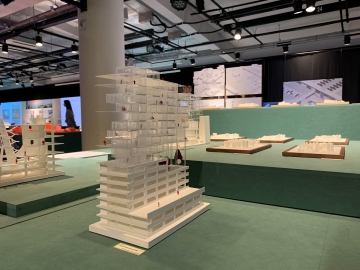
The 2019 Seoul Biennale of Architecture and Urbanism (SBAU), an international academic conference on cities and architecture, opened from Sept. 7 to Nov. 10. With the very first SBAU held in 2017, this is the second year to hold the conference in which Ewha students have also taken part.
The theme of this year’s SBAU is “Collective City.” The conference aimed to work with global partners to explore emerging models of collaboration and city-making at a global scale.
The conference mainly consisted of two parts: exhibitions and public programs. As for the exhibitions, there were five different types: Thematic Exhibition, Cities Exhibition, Global Studios, Live Projects, and Seoul Madang. Public programs were also divided into five different parts including educational lectures and tour programs.
Among the five exhibitions, Global Studios was run by students and scholars of renowned institutions. Schools including Harvard University, Columbia University, Seoul National University and more participated with their works. Ewha also participated in the exhibition with Radboud University students from Netherlands. The project was titled “PILaR(+) – No-regrets scenarios for the future of Euljiro.”
PILaR stands for participatory, inclusive and sustainable land readjustment. While common redevelopment processes disregarded existing features in the city as well as renting or leasing residents, PILaR has emerged as a redevelopment plan that can satisfy all stakeholders.
Yoon Ji-ye, a junior majoring in Architecture who participated in this project, explained about what they aimed to do. “We developed no-regrets scenarios for the development of the sites,” she said.
“We also carried out an extensive survey of the site in order to get a grasp of the collaborative capacity of existing residents and small businesses.”
Based on this idea, students were divided into teams and suggested five different scenarios. For example, Yoon worked on a project that created a loop in Euljiro to connect each block in the old roads. While visitors of Euljiro walk on this loop, they can experience the flow of industry in the region. Along the roads of the loop, the project also suggested creating pocket open spaces. These spaces are reserved for all merchants, residents, and outsiders as a place to gather and hold events.
When asked about why they chose Euljiro to suggest a redevelopment plan, Yoon gave a reply.
“Euljiro was once the center of urban industry, but with its decline, it is no longer the place it used to be. Various redevelopment plans were made and discarded, so the place has been neglected. As a redevelopment plan that satisfies all stakeholders has not yet been suggested, we thought that Euljiro was an adequate place to adopt PILaR.”
Ewha students took part in SBAU Global Studios due to a course they took in the first semester of this year. Professor Klaas Kresse’s Architectural Design class planned to participate in SBAU and those who were interested signed up for his class.
“A total of 13 Ewha students participated in the PILaR(+) project including 12 students majoring in Architecture and one exchange student,” Yoon said. “Seven students from Radboud University worked together with us.”
Ewha students worked to create visual materials even after the end of the first semester. They spent about six months preparing for the project. Yoon shared her thoughts on what she gained and felt through her participation in the project.
“It was a great experience to participate in a global scale SBAU as an Ewha architecture student. Through this project, I got to recognize arising problems when suggesting redevelopment plans. Ewha had participated in the very first SBAU, and I hope that we continue taking part to display meaningful projects.”

